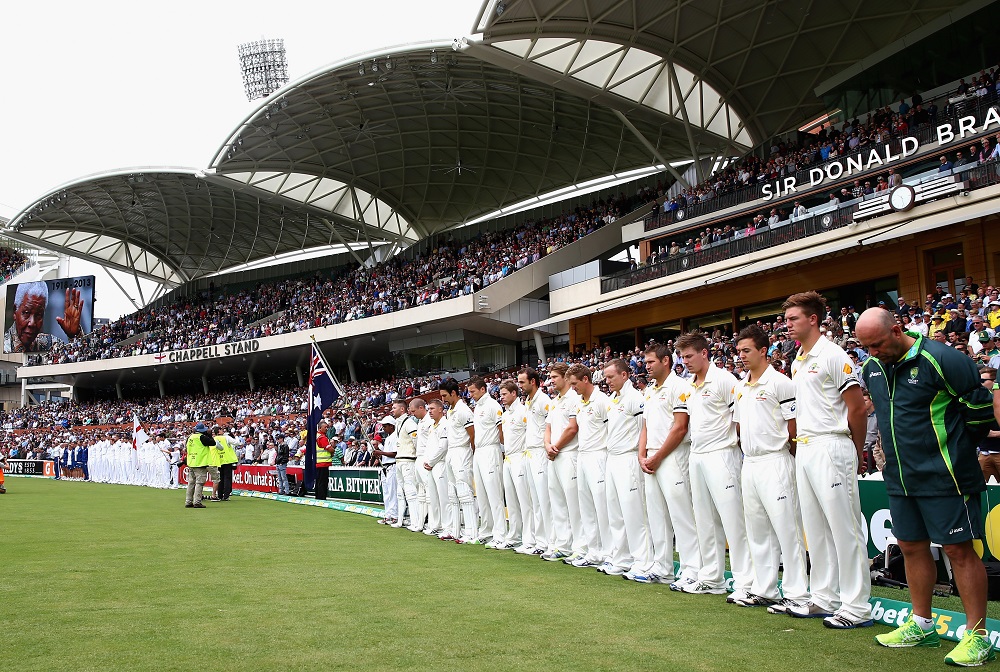Pringle column: Day/night Test victory in Adelaide should be targeted by Bayliss

Australia.
(Photo by Ryan Pierse/Getty Images)
Think Pink was the 1970 album by Twink, one time drummer for Hawkwind and the Pretty Things. Yet, cricket history suggests that England must do the same this winter if they are to boost their chances of retaining the Ashes.
True, the day/night Test in Adelaide using pink cricket balls will be an Ashes first for them, but it also presents their best opportunity of winning one of the first three Tests, the other two being venues at which England have not prevailed for decades.
James Joyce once said that history was “a nightmare from which he was trying to awake”, and so it is with England’s cricketers and Test matches at the Gabba and WACA, the two Tests that sandwich the Adelaide Test before the series heads for the festive season venues of Melbourne and Sydney.
Their last win at the Gabba was in 1986/7 while their lone victory in Perth, where resides the quickest, bounciest pitch on earth, was in 1978/9, against an Australian side severely weakened by defections to Kerry Packer’s World Series.
You can never say never in sport, and Joe Root’s team may well triumph at those two grounds this time. But if I was coach Trevor Bayliss, I’d be targeting Adelaide and the day/night Test with special measures, as one England must win despite Australia successes in the two matches already played there.
Traditionally, Adelaide usually produced a fairly docile pitch offering little to bowlers of any persuasion. Since the enclosing stands were built, the ball has swung more than before, though this is relative as Kookaburra balls don’t hoop around for long.
Yet, all those perceived wisdoms have changed since it first held day/night Tests two years ago. To support the confection, as well as the pinkness of the ball, extra grass was left on the pitch. As a result, wickets tumbled, most of them to seam. In theory, this should help England whose best bowlers, James Anderson, Stuart Broad and Chris Woakes, are all fine proponents of seam up.
A breakdown of the figures is revealing. In the first ‘Pink’ Test, against New Zealand in 2015, New Zealand’s seam bowlers took 12 of the 17 Australian wickets to fall in a low-scoring match the Aussies won by three wickets. Across the two New Zealand innings, the figure was 17 out of 20 wickets to the seamers. Discounting the run-out, which was not conditions driven, 81 per cent of the wickets in the match fell to pace.
In the day/night match there against South Africa a year ago, a higher scoring affair that Steve Smith’s Australia won by seven wickets, that figure was 80 per cent – a figure closer to that achieved at English Test venues rather than Australian ones.
The other interesting metric is the amount of those seamer dismissals which fell to catches – 17 in the Test against South Africa, 19 in the one against New Zealand. Getting edges to carry used to be a problem in the past at Adelaide, especially once the ball got old. Yet the pink ball, with its tougher, polymer coat, as well as the grassier pitches, deliberately produced to preserve its colour, means it now carries through better and for longer at Adelaide than used to be the case in the daylight Tests of yore.
Having played three pink-ball Tests to England’s one, the latter a brief, unrevealing affair at Edgbaston against the West Indies, Australia do have the slight advantage of knowing what to expect. England do have a day/night match at the Adelaide Oval against a Cricket Australian XI on November 8, of which not a minute must be wasted.
An England win will not be a shoo-in. If once you could be confident that England’s batsmen would cope better than the Aussies on surfaces offering sideways movement, their woeful batting against South Africa’s Vernon Philander last summer suggests otherwise. They will be in the game, though, something they weren’t during the last whitewash.
Run-making, while obviously more difficult than usual, is not impossible. Although the fact that only three batsmen passed fifty in the first ‘Pink’ Test will give many collywobbles, three did make hundreds in the second one, two of them opening batsmen. Gritty innings, however, something one of the centurions Faf du Plessis specialises in, seem to be what are required.
One definite way the day/night Test should help England is with the cooler temperatures night tends to bring. Recently, Mark Butcher talked of the Adelaide Test of 1998/9, when temperatures soared well above 100F. “It was so hot my eyeballs hurt,” he said recently. Needless to say, England were floored by the heat as well as a rampant Aussie side and lost by 205 runs.
The cooler evening clearly plays well with fans. In last year’s match against South Africa, 125,993 watched four days play, a venue record. This year, England supporters will make up a fair proportion of the crowd, expecting, as I do, Root’s team to notch a precious and vital win – visit Bet365 bookies ahead of a big Ashes for England.